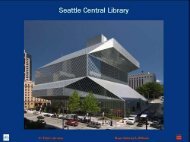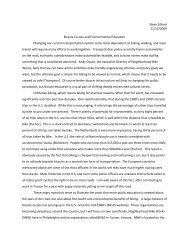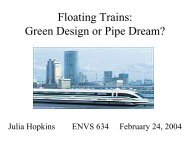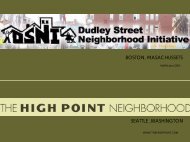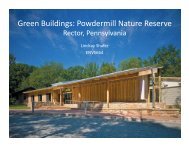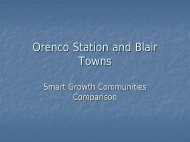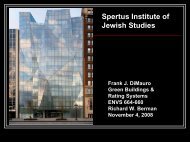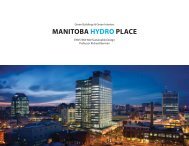Curitiba: The Poster Child of Bus Rapid Transit - Greendesignetc.net
Curitiba: The Poster Child of Bus Rapid Transit - Greendesignetc.net
Curitiba: The Poster Child of Bus Rapid Transit - Greendesignetc.net
You also want an ePaper? Increase the reach of your titles
YUMPU automatically turns print PDFs into web optimized ePapers that Google loves.
<strong>Curitiba</strong>: <strong>The</strong> <strong>Poster</strong> <strong>Child</strong> <strong>of</strong><br />
<strong>Bus</strong> <strong>Rapid</strong> <strong>Transit</strong><br />
Source: http://citytransport.info
<strong>Curitiba</strong>: Stats<br />
<br />
<br />
<br />
<br />
Capital <strong>of</strong> Paraná, southern Brazil<br />
Pop. 1.78 million (city), 2.4 million (municipalities)<br />
270 sq. miles<br />
Between São Paulo and Florianopolis
<strong>Curitiba</strong>: Growth<br />
<br />
<br />
Population boom<br />
− 1890s: 50,000<br />
− 1940s: Tripled!<br />
− 1960: 430,000<br />
− 2005: 1.78 million<br />
Obviously, something had to be done
Master Plan<br />
<br />
<br />
<br />
<br />
<br />
1964, city called for Master Plan proposals<br />
Enthusiastic response from young, idealistic<br />
architects from Fed. Univ. <strong>of</strong> Paraná<br />
Introduced car-free streets, rapid transitways,<br />
limits on development, green space, recycling<br />
incentives, moratorium on polluting industry<br />
Led by Jaime Lerner, approved in 1966<br />
Brazil was under military dictatorship
Master Plan<br />
Source: Vidisha Parasram, Horizon Solutions Site Intern
Pedestrian Street<br />
<br />
Rua XV de<br />
Novembro<br />
Source:<br />
http://www.curitiba.pr.gov.br
Green Space<br />
<br />
XV de Novembro<br />
Plaza garden<br />
Source:<br />
www.inepac.rj.gov.br
Trianary Streets<br />
<br />
<strong>Bus</strong>es run in the<br />
middle, other<br />
vehicles on the<br />
sides<br />
<br />
Source:<br />
www.mariavazphoto.com
Components <strong>of</strong> BRT<br />
<br />
<br />
<br />
Running ways<br />
− Designated high speed lanes,<br />
− Traffic signal priority to buses<br />
Stations<br />
− Reduce boarding time<br />
− Route info<br />
− Retail?<br />
Vehicles<br />
− Accessible<br />
− Enjoyable<br />
− Alternative fuels
Components <strong>of</strong> BRT<br />
<br />
<br />
<br />
Service<br />
− Integration with regional systems<br />
− Frequency – don't need schedule<br />
− Routes – easy to understand<br />
− Stops – convenient but quick<br />
Expedited fare collection<br />
− SmartCards, etc<br />
Intelligent Transportation Systems<br />
− Remote tracking and coordination for efficiency and<br />
safety
BRT: Design Innovations<br />
<br />
<br />
Some advantages <strong>of</strong> subways/light rail at<br />
less cost<br />
Boarding tubes<br />
− Elevated<br />
− Payment before boarding<br />
<br />
<br />
Accessibility<br />
Frequency <strong>of</strong> Service<br />
− peak hours, frequency
BRT: Advantages Over Light Rail<br />
<br />
<br />
<br />
<br />
No digging<br />
No laying electric lines<br />
Implemented quickly<br />
Did not take resources from current<br />
generation to benefit future ones
RIT<br />
<br />
<br />
<br />
Core <strong>of</strong> system is RIT<br />
− Integrated Transportation Network /<br />
Rede Integrada de Transporte<br />
Five major corridors<br />
Bi-articulated express buses<br />
− Up to 270 passengers.<br />
− Trinary roads<br />
<br />
<br />
Express buses every 70 seconds - 2<br />
minutes<br />
Single Fare (+/- $.40)
Bi-articulated buses<br />
Source: Institute for Research and Urban Planning <strong>of</strong><br />
<strong>Curitiba</strong> (IPPUC)
Outer Routes<br />
<br />
<br />
<br />
Conventional lines<br />
− Connect center with outlying<br />
neighborhoods<br />
Circular Center<br />
− Downtown loop<br />
Special Schools<br />
− Special needs students<br />
<br />
<br />
Inter-Hospital<br />
Tourism
System Map<br />
Source: pt.wikipedia.org/wiki/<strong>Curitiba</strong>
Boarding Tubes<br />
<br />
<br />
<br />
<br />
Pre-pay<br />
Accessible<br />
Shelter<br />
Speeds boarding<br />
<br />
Source:<br />
www.lightrailnow.org
Lerner on BRT's Needs<br />
Dedicated lanes<br />
<br />
Not just lines, physically separated and at center <strong>of</strong> the<br />
street<br />
Fast<br />
<br />
Stops every1/3 mile, not every block<br />
Transport 2 million people at 30-second to 1 min intervals<br />
Capacity comparable to subway<br />
<br />
“When we started out, we thought our system could hold<br />
us until we could afford a subway. Now I'm sure we don't<br />
need a subway.” - Source: Sierra Magazine
Administration and Operation<br />
<br />
<br />
Public-Private Partnership<br />
− City corporation determines routes, fares,<br />
schedules, and money<br />
− 10 private operators drive, provide vehicles,<br />
etc<br />
Operators paid by distance, not ridership<br />
− Avoids key issue <strong>of</strong> underutilized routes
Results:<br />
<br />
<br />
<br />
<br />
<br />
Development along corridors -> thriving<br />
downtown<br />
Serves over one million passengers per<br />
workday<br />
28% <strong>of</strong> the ridership used to drive<br />
Relatively low 10% <strong>of</strong> income spent on<br />
transportation<br />
30% less fuel per capita than other<br />
Brazilian cities
Results:<br />
<br />
“<strong>Curitiba</strong>'s population <strong>of</strong> 1.8 million<br />
consumes 23% less fuel per capita than<br />
the Brazilian national average. <strong>The</strong> city<br />
has 16 parks, 14 forests, and over 1,000<br />
green public areas shared by its<br />
residents.”<br />
− http://www.citymayors.com/environment/biodive<br />
rsity.html
Portability<br />
<br />
<br />
<br />
Economist: ported successfully to Quito,<br />
Bogotá, Jakarta, Brisbane, Ottawa<br />
But “Imperfections <strong>of</strong> democracy”<br />
(lobbying) prevent full adoption<br />
Lerner cites more that 60 cities using<br />
some aspects <strong>of</strong> BRT
FTA BRT Initiative<br />
<br />
Studying results in<br />
− Eugene, OR<br />
− Orlando, FL<br />
− Cleveland, OH<br />
− Ottawa, ON.
LA Orange Line<br />
<br />
Strong opposition from Light Rail champions<br />
− City not dense enough<br />
− Americans would not tolerate crowding<br />
<br />
Mixed response early on<br />
− Happy passengers<br />
− Concerned residents<br />
<br />
First week, traffic accident caused early<br />
discussions about gating bus lanes
Impediments to Portability<br />
<br />
Differing tolerance <strong>of</strong> different riders<br />
− Haven't read complaints about crowding?<br />
<br />
Urban planning does not happen in<br />
tandem<br />
− <strong>Curitiba</strong>'s system depends on a city planned<br />
around it
Conclusion<br />
<br />
<br />
Public-Private Partnerships on case-bycase<br />
basis<br />
Recommend that cities consider<br />
implementing components<br />
− Low cost<br />
− Can be rolled back<br />
− Could solve entrenched problems



